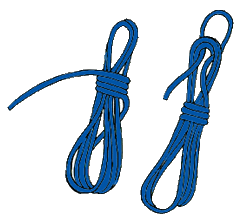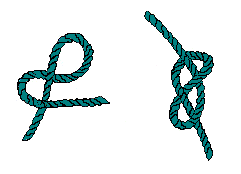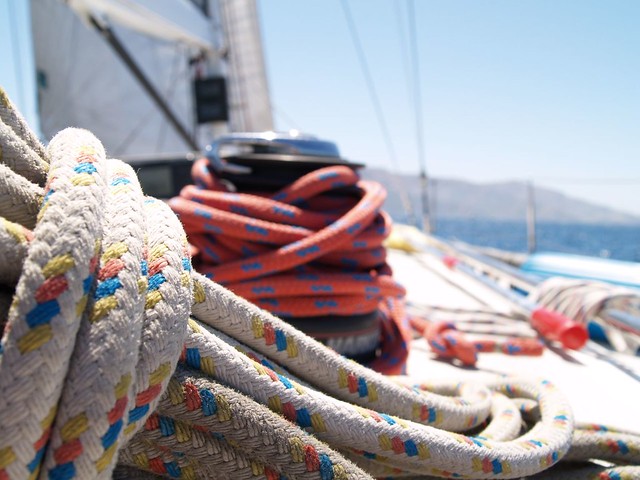Sailing Lines, Ropes & Knots
Sailing Lines and Knots play a key role in Sailing. Some purposes of lines include hoisting and lowering the sails and securing the Sailboat. Moreover, Sailing Knots are useful in many tasks while on board.
Handling lines (ropes) and tying knots is one vital skill. There are many varieties of lines and kinds of knots that are used in a variety of situations. Like tying up a Line to a piling or post, joining two lines, and securing a rope to a cleat.
Know All About Sailing Lines and Knots In the Following Sections
Sailing Lines – Care and Maintenance
In Sailing, many different Lines are used for a variety of purposes. For clarity, almost every line used in a Sailboat has its own term. Know the terms used to identify different Lines in the sport.

Here Are Some Types Of Sailing Lines
- Halyards – used to raise and lower the Sails
- Sheets – used in Sail Trimming
- Vang – keeps the boom from lifting
- Preventer – controls the sideways motion of the boom
- Docklines – used in securing a Sailboat to a dock
Since Lines are essential features of Sailboats, it is imperative to take good care of them and keep them away from elements that may contribute to the wear and tear or deterioration of Lines as time progresses.
Here Are Some Guidelines in Keeping Your Lines in Their Good Condition:
Avoid Frayed Line Ends
It will be hard to tie Sailing Knots if your Lines have frayed ends. Moreover, they look messy and worn out. To avoid having frayed ends, seal Line ends with proprietary liquids, glue, or adhesive tape. Make regular checks of your Lines so fraying (if any) will be attended to before it gets worse.
Clean the Lines
Dirt, dust, and other particles can accumulate in strands of the Lines. This buildup of dirt can affect the performance of Lines over a certain period of time. Scrub the Lines in a bucket of water and mild detergent. Coil the Lines and let them dry.
Store Lines Properly
Coil Lines when not in use to avoid kinks and tangles. Make sure they are coiled properly before storing them. Otherwise, they will get tangled up. Just imagine the effort and time you need just to straighten out various sorts of Lines that you need. Coil three-strand Lines in loops, while braided Lines should be in figure 8 coils.
These are some tips in taking care of Lines on your Sailboat. Proper Care and Maintenance of Sailing Lines is all you need to extend their life and to ensure that they are in good condition every time you go sailing.
Sailing Lines – Features
Lines (or ropes) are very essential in Sailing. Securing the Sailboat and Sail Trimming are just some of the many uses of Sailing Lines. They come in various types, depending on what material they are made of as well as the manner of construction. Moreover, each line has its own features and strength.
The above aspects of Lines are important to know so you will learn the strengths and weaknesses of the Lines that you use. In this section, get acquainted with the different Features of Sailing Lines:
Sailing Line Material
Nylon, Dacron, and Kevlar are three materials commonly used in making Lines. Other materials are Polypropylene and Polyester.
Nylon – strong (stronger than Dacron), elastic, used for anchor and/or dock lines
Dacron – often used for Halyards, low stretch
Kevlar – often used for Halyards, low stretch
Polypropylene – stretches a lot, used in making mooring lines and safety lines
Polyester – strong, low stretch, does not float
Structure
The manner of construction and diameter of a Line determines its strength, durability, and stretch. Lines can be braided or three-strand.
Braided – In this type of structure, yarns are lightly twisted into strands. Then these strands will form the core of the line.
Three Strand – Three twisted strands are then twisted together to form the line.
These are the essential Features of Sailing Lines. Knowing these aspects will enable you to determine the strength and stretch of your Lines and therefore, will inform you of how dependable your Lines are.
Sailing Knots
In Sailing, there are many knots that come in a variety of features and purposes. Sailing Knots are useful in various situations, such as joining two Sailing Lines, tying up to a piling or post, or securing a Sailboat.
In this section, know the common Sailing Knots and learn how to make them:
Figure 8 Knot
This is perhaps the easiest knot to do. This is used as a stopper knot. It keeps the line from slipping out of things.
- Make a crossing turn. The working end should be on top, and the standing part should be under it.
- Take the Working end on top of the knot and pass it through the middle of the Crossing turn you made earlier.
- Pull it tightly.

Sheet Bend
This knot is used in tying two Lines with the same or different sizes. When tying Lines of different diameter, make the loop in the thicker line.
- Make a loop in one of the Lines. Get the Working end of the other line and pass it through the loop from below.
- Pass the Working end of the second line around and under the short end of the loop.
- Put the Working end of the second line over the end of the loop, and then on top, and then pass it below itself.
- Pull the Standing part of the second line as well as the loop to tighten the knot.
Bowline
One distinctive feature of a Bowline is that the more load it has, the tighter it holds. This is usually used to tie to a ring or post.
- Make an overhand loop in the Standing part.
- Insert the Working end from below through the loop.
- Pass the Working end behind the Standing part.
- Pass the Working end through the loop (from the top).
- Tighten the knot.
Clove Hitch
This knot is used to secure a Sailboat to a post.

- Make a turn around a post. The Working end should be on top of the Standing part.
- Using the Working end, make a second turn around the post.
- Insert the Working end under the second turn.
- Pull on both the Working end and Standing part to tighten the knot.
Round Turn Two Half-Hitches
This knot is used to tie a line to a post or ring.
- Make a round turn on the post (or ring).
- Put the Working end above the Standing part.
- Pass it below the Standing part and then insert it under itself.
- Repeat Step 3.
- Pull the Working end and Standing part to tighten the knot.
These are the basic Sailing Knots. You do not need to master a lot of different knots at once. What you need are simple ones that will help you on your trips. You will be able to do them instinctively as you gain experience.

Sailing Lines, Ropes & Knots – Summary
These are the things you need to know about Sailing Lines and Knots. Make sure you know what to do with lines and how to make proper knots for your trip.
